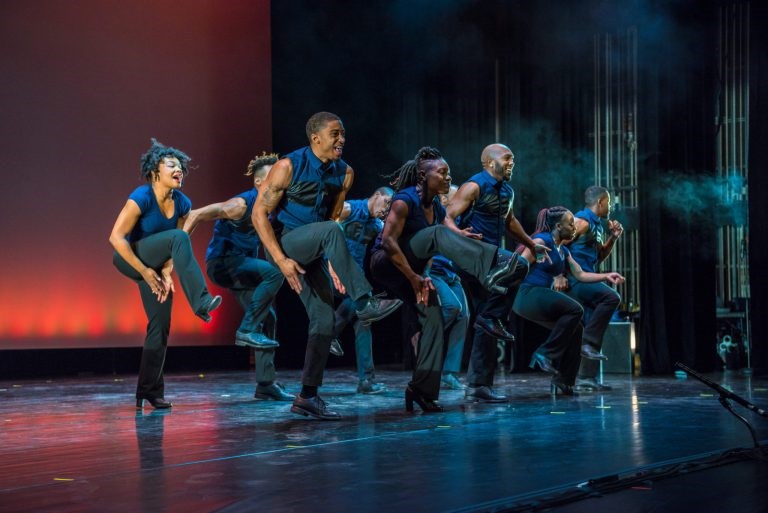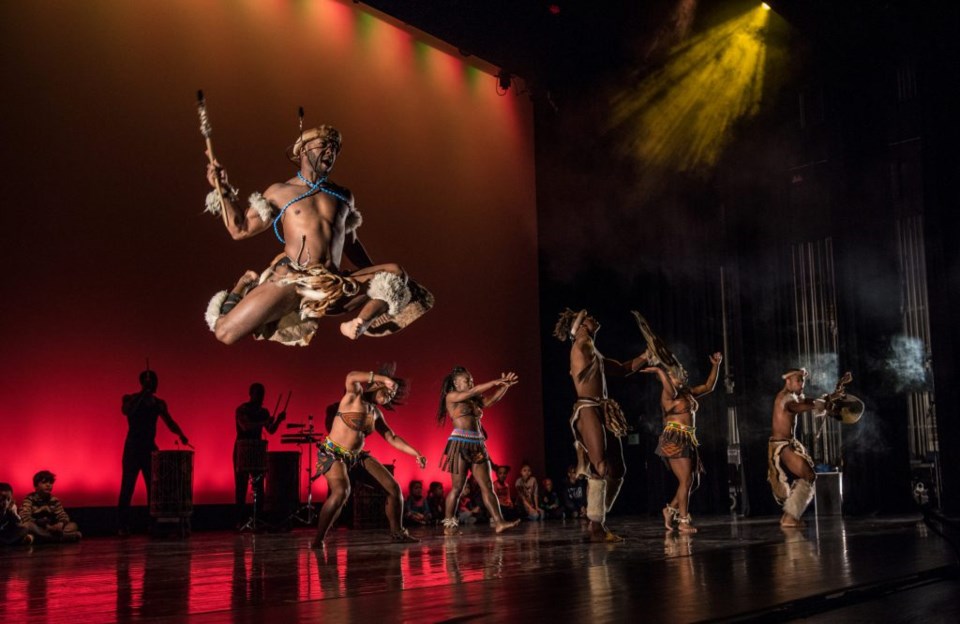Step Afrika!'s performances are much more than dance shows: They integrate songs, storytelling and are all about audience participation.

Step Afrika!, the vibrant blend of percussive dance styles practiced by historically African-American fraternities and sororities, African traditional dance and influences from a variety of other dance forms, returns to Brooklyn's Kumble Theater on Saturday, April 28. Presented by the Brooklyn Center for the Performing Arts, the upcoming Brooklyn residency will include a program that combines new works with favorites as well as an excerpt from The Migration: Reflections on Jacob Lawrence, which charts the story of African-American migrants moving from the South to the North in the early 20th century.
Founded in 1994, Step Afrika!'s performances are much more than dance shows: They integrate songs, storytelling, humor and audience participation. In addition to its rigorous touring schedule, the ensemble also promotes stepping as an educational, motivational and healthy tool for young people with a focus on teamwork, academic achievement and cross-cultural understanding.
Brooklyn Reader had the opportunity to learn more about the origins of stepping and the evolution of Step Afrika! in a personal conversation with C. Brian Williams, the company's founder and executive director.
Stepping is a polyrhythmic, progressive dance form created by African-American fraternities and sororities, an art form that is more than 100 years old.
Brooklyn Reader (BKR): Mr. Williams, can you tell us more about "stepping?"
C. Brian Williams (CBW): Stepping is a polyrhythmic, progressive dance form created by African-American fraternities and sororities. The art form is more than 100 years old and its origins stem from the time when African-Americans first attended colleges in greater numbers in the early 1900s. In stepping, the body is used as an instrument. It is African-American body percussion, which dates back to the early 1800s.
BKR: What inspired African-Americans to use their bodies as a drum?
CBW: African-American body percussion can be seen in styles such as tap, beatbox and the ring shout (a dance that creates drum rhythms through the shuffling of the feet). South Africa, actually, started doing some research into these body percussion techniques. The big questions were: Where is the drum? Why didn't we (African Americans) just use the drum? When did our bodies become the drum for us?
The research led us to the Stono rebellion of 1739, during which the drum was used to rally enslaved Africans. The insurrection was eventually quashed, but it created the Negro Act in 1740 where Africans in South Carolina lost the right to read, to write, to assemble and to use their drums. That's when Africans started to use their bodies as instruments. And that's where rich traditions such as the ring shout originated.
By the time of the emancipation, African-Americans were already accustomed to using the body as a drum. So it was quite natural for African-American fraternities and sororities to use body percussion as a way to express themselves. They called on the spirits of their ancestors by performing the ring shout and the pattin' juba [a dance that involves stomping as well as slapping and patting the arms, legs, chest and cheeks] to create a traditional dance that makes sense to them.
Whenever we step onto the stage, it is an opportunity to highlight how the arts can bring cultures together, people from various many backgrounds.
BKR: What inspired you to pick up stepping which eventually led to the formation of Step Afrika!?
CBW: I've come to stepping in the most traditional way possible: I joined a historically black fraternity, Alpha Phi Alpha Fraternity Inc. Prior to 1988, the only way to learn about the art form of stepping was through this fraternity-sorority system. Even though I am a fourth generation alumnus of a historically black college (HBCU), I had never seen the art form before — it was that privately held.
In 1988, Spike Lee released School Daze which opened the floodgates: The art form spread throughout the African-American community and high school step teams developed. Lee's movie opened this treasure chest of what we have been doing over 80 years and it inspired me to look deeper into this art form.
After graduating from Howard University, I got my first job in South Africa where I saw a dance form called the South African Gumboot dance. I was shocked to see how similar it was with our traditional stepping. I did more research on the various forms of tap and stepping throughout the world. I was trying to figure out how I could connect the continent of Africa, particularly South Africa, with African-American culture. And that's how the idea of Step Afrika! came about: Stepping meets South African Gumboot while bringing our people together.
BKR: So Step Afrika! is about bringing people together?
CBW: For me, whenever we step onto the stage, it is an opportunity to highlight how the arts can bring cultures together, people from various many backgrounds. We believe firmly in artistic and cultural exchange as a platform to display how similar we are. And this is across all cultures.
BKR: Step Afrika! tours nationally and internationally. How do you achieve that connection with a very diverse, global audience?
CBW: When we hit the stage, we immediately try to break the wall between artist and audience. We do not want that traditional show where the audience just observes. We really want them to participate and be involved in the performance as much as possible. To make noise, to make music with us, just to feel very free. Dance has that power to create without speaking words. We genuinely invite our audiences to participate, regardless where they are from. We've been to about 70 countries so far, and we've seen tremendous responses from our audiences around the world.

BKR: You are coming to the Kumble Theater on Saturday, April 28. What can the audience expect?
CBW: We will be presenting an introduction to the history of stepping. We will also focus on our roots in South Africa by performing one of my favorite dances, a highly physical, athletic dance created by the Zulu people. Since we've been to Brooklyn already twice, we will be presenting different works, from Step Afrika!'s inception to the present, to allow the audience to see more of our company.
The Brooklyn Center for the Performing Arts Presents: Step Afrika!
When: Saturday, April 28, 3:00pm & 8:00pm
Where: Kumble Theater at LIU-Brooklyn, 1 University Plaza, Brooklyn
How much: $35. For tickets, go here.



